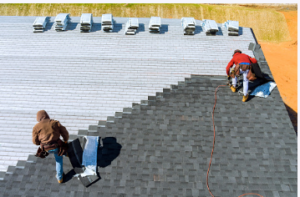Your roof is an integral component of your home. It helps to prevent leaks and keep the rest of your house dry and secure.
Your roof, like everything else in your home, requires occasional roof repairs Adelaide. While replacing a roof can be expensive, there are ways to cut costs without compromising its integrity.
Look for Water Spots and Discoloration
 When you spot water spots on your ceiling, you must identify the cause. These could indicate a roof leak or other plumbing or heating issue. Depending on the spot’s severity, you may be able to fix it yourself or contact an expert for assistance.
When you spot water spots on your ceiling, you must identify the cause. These could indicate a roof leak or other plumbing or heating issue. Depending on the spot’s severity, you may be able to fix it yourself or contact an expert for assistance.
When your home’s roof has excessive moisture, water spots may appear on the ceiling that appears yellow or brown. While water spots are common on roofs, they can also appear on walls or other surfaces as a warning that there is an underlying leak that needs to be addressed promptly.
Inspect your roof and attic to determine if you leak. If the roofing is in good condition, it should be relatively straightforward to identify where it originates; however, older roofs may make it more challenging to locate its source.
As a general guideline, water spots on your ceiling will typically originate near roof vents or other areas with cracked or damaged shingles. However, if they’re farther away from these points, it could indicate that a leak has occurred elsewhere in your home.
It is also wise to inspect for ice dams, which can cause stains on the ceiling along outside walls due to melting and refreezing snow and ice trapped under your roof that eventually leaks into your home.
Once you’ve identified the cause of the water stain, please take action to eliminate it. A bleach and water solution may work to take out the colour, but be careful not to get too much liquid on your ceiling as this could promote mould or mildew growth. Furthermore, ensure the area is arid before refinishing to avoid future stains.
Check the Gutters
Gutters are essential to any roof, diverting rainwater and snow from the house. It minimises water damage to a home’s foundations, siding, and other parts.
Gutter care is essential, however. Without regular roof repairs Adelaide and upkeep, water can seep into your foundation and cause extensive damage over time.
A blocked gutter could allow water to pool on your roof, potentially damaging its membrane or even leading to a leaky roof. Other issues, such as ice dams, may also arise.
Ineffective gutters can lead to moisture build-up in your basement, creating an unpleasant odour and potential mould issues and foundation deterioration.
One of the most obvious signs that your gutters need attention is if they fill with water while being cleaned. It could indicate a blockage somewhere in the system or that water is not draining correctly from them.
Overflowing gutters can also wreak havoc on your home’s walls by allowing water to seep into masonry and mortar joints, leading to cracks that could penetrate timber or paint. Again, this would necessitate extensive masonry repairs, which may prove expensive in the long run.
Look at the Shingles
Before repairing a roof, you should take a few essential steps. One of the most crucial is inspecting the shingles to see if they have been damaged; otherwise, your shingles won’t be able to protect your home as effectively from external elements as expected.
Your shingles are composed of various materials; some are metal, and others are rubber. Both types are durable and weather-resistant, but which best fits your needs depends on your roof type.
Curled shingles are another sign of extensive damage, as they allow rain, snow and ice to build up on your roof instead of sliding off. It can enable standing water into your attic, which damages your home’s structure.
When a shingle is damaged, it can lose its granules and become brittle. This condition is common among asphalt shingles but easily fixed with roofing cement and nails.
As a rule, the first signs of shingle damage can often be observed with the naked eye. For instance, if your shingles have sun-bleached colours after sun exposure, that could indicate cracking or breaking in their surface.
If you’re unsure what to look for when inspecting your roof, take a walk with binoculars. It will give you a better view of problems before they become more prominent.
Once you’ve identified any potential issue areas, document them in writing. Doing this can be invaluable if you ever need to file an insurance claim.